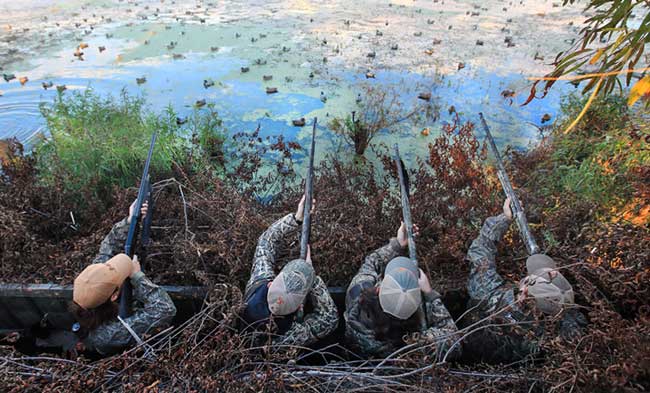Will Lindsey | Mossy Oak ProStaff

Our duck blind is a work of art. We’ve taken plywood panels and mounted them to the base of an old pontoon boat. We can shoot seven hunters out of this blind. But most of the time, we only hunt five, because the blind is much more comfortable with only five hunters in it.
We believe that the camo our shooters wear is just as important as the brush we use to hide the blind. So, we wear Mossy Oak Bottomland /camouflage/bottomland. I’ve found that Bottomland camo fits in with any kind of hunting that I do, not just waterfowl hunting. Our blind sits right on the edge of the water. That Bottomland camo looks like tree trunks and the limbs that we use to brush-in our blind. We primarily use buck brush with no leaves. We not only cover the sides of the blind with buck brush but also use it on top of the blind. We’ve created shooting ports too.
If you're hunting in a good duck spot, you'll often have another blind near you. The closest blind to our blind is about 400 yards away. We really don’t have that much competition for the ducks between the two blinds. We may be able to call the ducks off that other blind, but that’s not really sporting. If they see a group of ducks and start calling to those ducks, we usually won’t start calling to the same flight. For the most part, they follow the same procedure with us. This way, both blinds get plenty of shooting, and we honor one another by not trying to fight over the same flight of birds.
I'm often asked, “What are you doing to get those birds within 15 or 20 yards of the blind before you call the shot?”
We usually create a really tight decoy spread with a very small pocket in front where the ducks can light. If we have a big flight of ducks come in, many of them will start lighting in the decoys as well as in the pocket we’ve created.
Another question I'm often asked is: “With what guns and shells do most of your group hunt?”
We primarily hunt with Remington 870s and Berettas. If high winds are in our area on the day we’re hunting, we generally shoot BBs or triple BBBs. If we don’t have high winds, we may shoot #1 or #2 shot.
None of our hunters have retrievers. So, when we have numbers of ducks on the water, we usually pick up our ducks. We want to make sure we haven’t gone over the limit. Normally, on a good morning, we can get a limit every 30 minutes. Since this was opening weekend for duck hunting, and we had seven guns in our blind, we started shooting about 6:13 a.m. and finished our limit about 9 or 9:30 a.m.
Twenty-three-year-old Will Lindsey from Jackson, Tennessee, has been hunting waterfowl for 12 years. He just graduated from the University of Tennessee at Martin with a degree in wildlife and fisheries. While in school, Lindsey could hunt ducks for 56 days before his classes. But since he’s taken a real job, he’s having difficulty hunting as many days as he would like. His favorite camo is Mossy Oak Bottomland - not just for duck hunting but for any type hunting he does. A Mossy Oak Pro for about a year, Lindsey hunts waterfowl near the Moss Island State Wildlife Management Area (WMA), north of Memphis and Jackson in the Hales Point region.






























